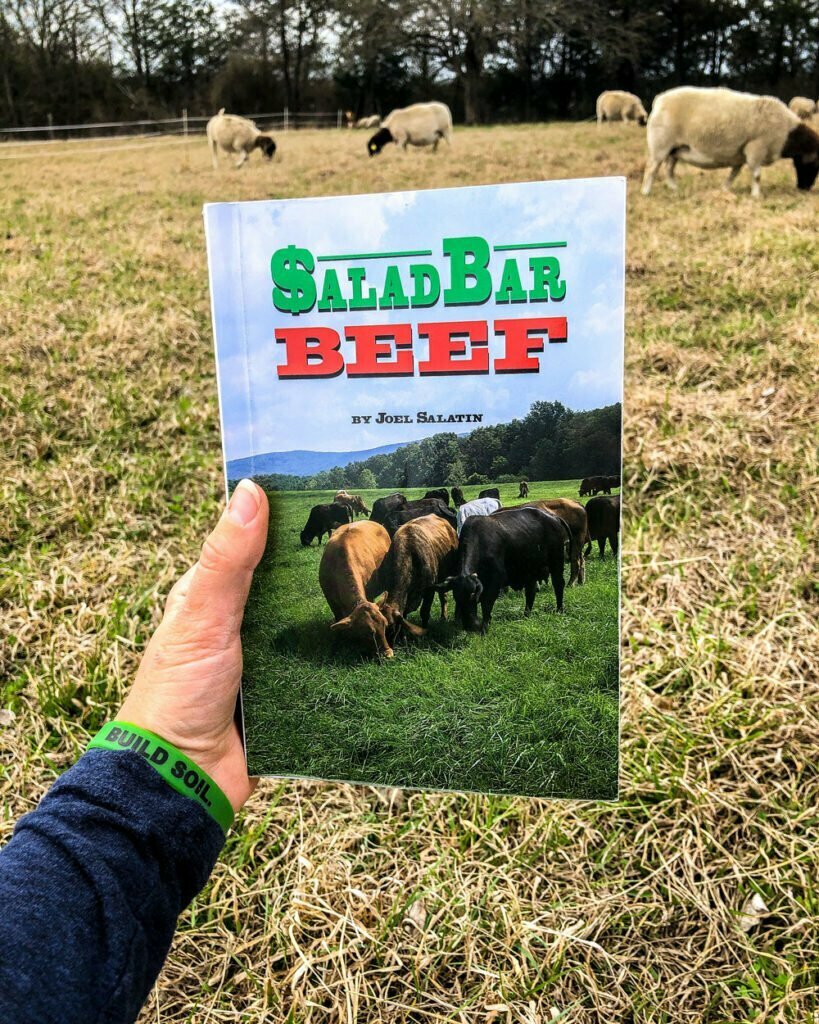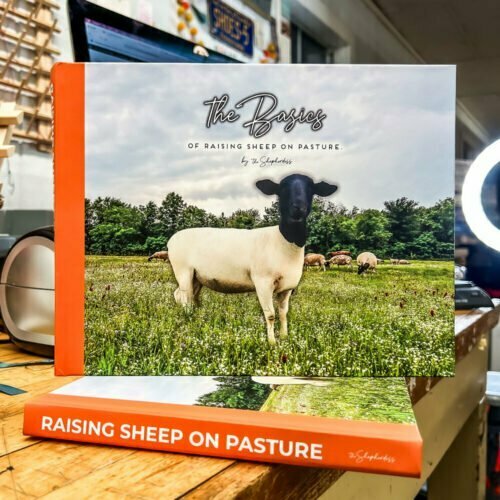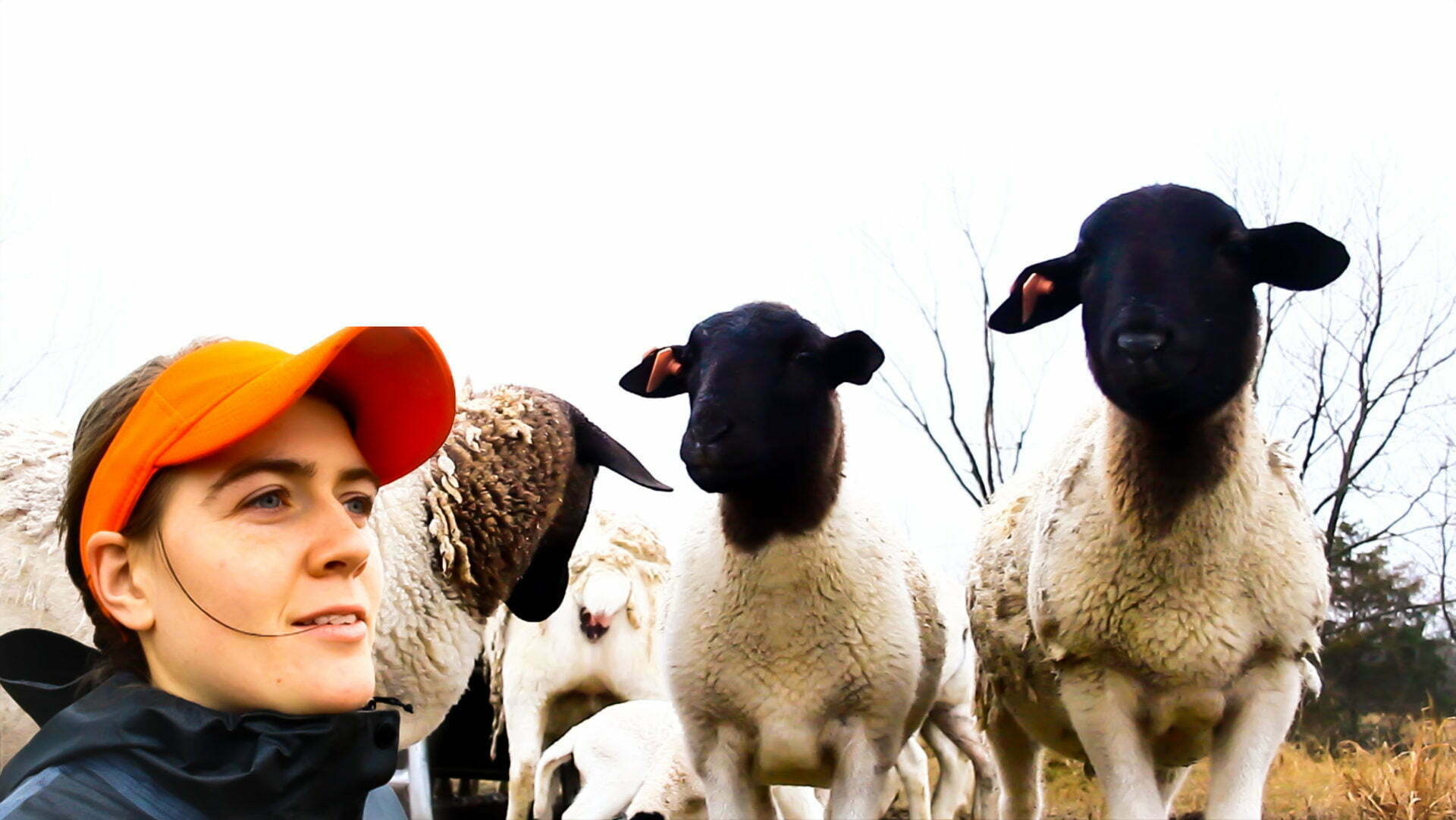Last week I brought home over 1000 pounds worth of grass fed beef. This is beef that I grew myself… with absolutely no previous experience in agriculture… Today I am bringing you all the details: from all the costs that went into growing 1000lb of beef, to a step by step process on how I did it.
When I had this crazy idea back in 2020 to raise grass fed beef, one of the first things I did was buy this book: Salad Bar Beef by Joel Salatin, which is available at ShopShepherdess.com. I’d love it if you would buy it there and support my farm. But I bought it knowing nothing about cows, or farming. And to be honest, I bought it because it had cows and dollar signs on it, whispers which are two of my primary interests right now… and sheep of course. But overall, the Lord had a bigger picture in mind by directing my steps to Salad Bar Beef because it not only gave me a complete 101 on how to raise Grassfed beef… it was also my first introduction to the concepts of regenerative agriculture, rotational grazing, and it ultimately was the book that laid the foundation for much of what you see on this channel.
The best way to get started in Grassfed beef:
For my first go at raising Grassfed beef I purchased three 7 month old steers from a local rancher. There are two HUGE reasons that I went with steers instead of a breeding cow. First I penciled out the timeline. If I was to buy and breed a cow it would be 33 months before I had beef on my plate. Buying a 7 month old steer would put meat on my plate within 18 months. Huge reason number 2 is that maintaining a breeding cow entails the expense of not only buying, but carrying the mama-cow indefinitely and potential for complications at and after birth. Any rancher will tell you that if you are going to have complications with livestock, most of them are going to happen in the birth to weaning time period. You also have the hassle of either buying or renting a bull to breed to your cow.
With all of this swirling in my head, the weaned steers became an easy choice. These steers came vaccinated, dewormed, acclimated to grazing, and ready to go. The only thing I did was deworm them with Ivermectin each of the two springs they were with me, but beyond that I just grazed them across my 23 acres for 18 months.
I bought these 3 beef Steer from my friend and local cow-calf rancher Karl Ebel. He was (and still is) a primary resource for me as a beginner in ranching and you can click on this video for more about him.
I had no livestock trailer, so he delivered the steer straight to my pasture. He charged a 10 cent per pound premium for buying the steers off pasture. This included delivery and was honestly, an exceptional favor to me as a friend.
BREED:
2 Herefords
1 black baldie (an Angus-hereford cross)
How Much land do you need to raise grass fed to finished beef? You need 3-5 acres per steer to raise and finish it on all grass. 3 acres per steer if you have fairly dense grass are moving your cows to a new paddock every day. 5 acres if you are moving your cows once a week or once every two weeks. I want to note here that running a grass-finishing operation does requires more land than a seasonally-synced breeding operation. So keep that in mind! You need more acreage for a finishing operation.
The way I grazed these steers was that I allowed them to go into every pasture and graze first. I gave the 3 steers large 3-5 acre paddocks and let them graze for 7 days. Then, I would bring my sheep and breeding cow herd through and pressured them graze the leftovers by putting them in smaller 1 acre paddocks. This ensured that my finishing steer were always eating the cream of the crop. I maintained this “finishing steers go first” program through to the very end and it worked great.
**As a sidenote, you will need more acres per animal for a grass-finishing operation than you will for strictly a breeding operation.
Costs:
I had 3 costs: cost of the animals, cost of feed overwinter, and cost of processing.
**Some are going to cite the cost of land should apply here, but I have-not done so. I worked out an arrangement with my family that would supply them with a certain amount of Grassfed beef at-cost in exchange for the use of the pasture to graze on. If you don’t have your own land, I want to encourage you to think creatively like this. Maybe someone in your family, your church, your local community has underutilized land… tell them you want to use it to grow beef, give them your plan, and give them a generous cut of the action once your harvest comes in.
**This is family property, but the land owner that I am working with was initially REALLY apprehensive about me raising beef cattle on his pasture. He agreed, but was afraid of having a bunch of wild cows running around. He was concerned they’d be unmanageable due to their size. However, as I grazed them for 18 months his mind was completely changed. He watched me handle them daily, he watched them come at my whistle like a couple of puppy dogs, and he watched as they grew fatter and fatter on grass that he would have otherwise had to pay to have hayed or mowed. When it came time to open up a box of the richest red grass fed beef, this landowner was completely won over and said that the doors are wide open for whatever I want to raise on his pasture.
So be encouraged and maybe even share this video with someone who is on the fence about leasing their land to you.
Cost of Steers:
I paid $1.83 per pound for these steers and they weighed 490lb when they arrived on my pasture. The total cost per steer was $909.51, or $2728.53 for all three.
Cost of the first overwintering the first year:
Beyond that initial investment of $2728.53, overwintering was the only time I pulled money out of my pocket to raise this beef. My first overwintering cost $525 and the second overwintering cost $168. You read that right: The first overwintering, I overdid on inputs simply for lack of experience. I didn’t understand the concept of stockpiling grass (click this video for more info), so I completely disregarded the acres of warm season stockpile as “useless” and fed the steers 7 round bales. Despite the fact that the steers were twice the size in their second winter, feed input costs were almost 1/2 of the first overwinter. Here is a breakdown:
1st overwintering for 3 yearlings:
7 round bales @ $50 each (free describe the agreement): (could have gotten away without, link to the 50c cows video)
9 bags of Cattle Cubes @ $15 each (150 lb each)
2 Bags of beef mineral mix from my local farm store
Total cost for the first overwintering: $525
2nd Overwintering for 3 full grown steers:
8 bags of cattle cubes @ $16 each (3/4 lb cubes per day from November 1-April 15th (Or 165 days))
2 bags of beef minerals.
Total cost for the second overwintering: $168
**A note on these cattle cubes: You may be thinking: “Wait, cubes for Grassfed beef is cheating!” The AGA, which is the American Grassfed Association has a list of approved supplements that can be fed to beef cow and still retain a 100% Grassfed label. The cubes were given not as a dietary baseline, but as a tool to maintain optimal rumen function while grazing winter pasture. Supplements of this nature are permitted under AGA guidelines so long as they do not pass a certain quantity. I don’t give a lot of merit to labels or regulatory standards… I urge consumer to educate themselves on where they buy from rather than relying on govt. labels. HOWEVER, if you want a complete list of AGA guidelines for Grassfed beef I have put the link to it below. https://www.americangrassfed.org/standards/AGA_Grassfed_Standards_Sept_2010-Final.pdf
Processing cost for 3 steers:
Processing fee for 3 steers at a STATE inspected facility: $1,695 or $565 per steer.
Bumper pull trailer rental: $75
Gas for Hauling: $90
Paying my brother to do all of the driving for the day: $200
$2059.76
Total cost: $5481.29 or $5.48 per pound of Grassfed beef.
I think the bottom is that you can do this. If you have a way to get ahold of the land… YOU SHOULD DO THIS.
I can’t explain the feeling of looking at 27 boxes of the highest quality food that can be produced and knowing that, by God’s grace, I produces it on 23 acres that was laying largely dormant. I had a flashback to when I stood right here and said “If I can take a resource that I have and convert it into a desirable finished product, that can be a very profitable situation.” And it’s really overwhelming to be here two years later. These cows were a major tool in a bigger plan than I could have come up with for myself and to be here looking back is humbling.
I’d love it if you would leave e a comment below if you’ve been following since the beginning. I want to thank you personally for it. If you haven’t been following since the beginning my whole entire farming history is documented here on YouTube, so just start from the beginning for the story.




Nice story 🙂
You are an intelligent God fearing woman with excellent business practices. I participated in your very first podcast and enjoy your articles.
Thanks
God bless
Chris
Louisiana
I love your work, Grace. Very well broken down and easily understood. God bless you in your endeavours. Love from Australia.
Great information. After you processed the three steers, did you go and purchase more steers? What do you recommend?
Do you ever recommend buying a breeding cow?
Thanks for the question! Yes, I did buy more steers as well as a few breeding cows :).
Hello Ms. HS,
I am a Vet who very much interested in eating a healthier brand of beef. I had plans to this very same plan, but in lost a leg due to a long battle with a bone infection. So, now I am seeking a different path the Lord has for me. I live in north east of Dallas and I am trying to find a local vendor of grass feed beef in a med to 1/2 steer amount. Is this reasonable? What should I expect to pay?
I am interested in buying lamb too. Thx so much for your transparency too
Dean B.
Hello and THANK YOU for making the effort to support small farms. I am sold out for the year, but PLEASE got to eatwild.com for a directory that will connect you with your nearest small farmer.
Books are a great way to start to learn about cattle raising, but does not beat just going hands on and learning by experience. Congratulations.
This is what I’m trying to do! It’s been 3 years for me. I don’t have great resources because people are unreliable! But between books and bits of information here and there I get it done. I would love to have more farmer ladies to trade ideas with. I have butchered two dairy cows which turned out fabulous but of course, less meat for the time/work. I also have a full time job and a slew of kids which makes it very hard to balance and I’ve lost a few calves due to not catching signs early enough. This process is definitely worth it. The meat is definitely worth it.
Join me for my Monthly Livestream at FarmerMeetup.com! There is a great community of encouragement there!
I’d love to do this! Lord help me .. I’m a single mom of two kiddos . We don’t have land but I do have a lot of friends and church community I could ask around!?!